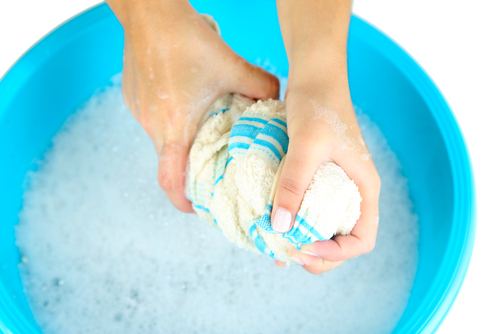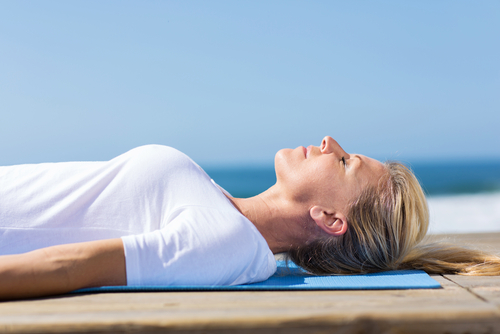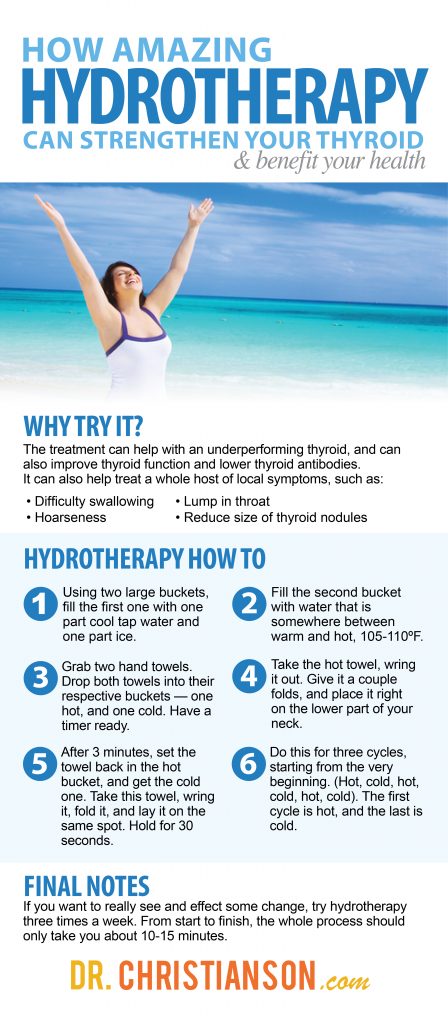Is cold water bad for your thyroid? Today, I want to discuss the relationship between cold water and your thyroid. As well as contrast hydrotherapy for your thyroid.
What if there was a free, easy, and better way to make your thyroid feel stronger than ever before? There is, and it comes in the form of hydrotherapy.
I want to talk to you about this natural process that is easy to do. Just how it can benefit your thyroid (and your life). Want to learn more about the process? I’m here to show you the steps today.
A History of Hydrotherapy
As a naturopathic doctor, I am a part of a long lineage of medical thinking that goes back hundreds of years. This is where hydrotherapy finds its roots as an ancient science. Part of that aforementioned lineage was what was known as the “European spa tradition.”
No, I’m not talking about going to a spa for a facial. Although there is absolutely nothing wrong with a nice facial now and then. I am talking about spa centers that were intentionally positioned away from the city.
The big belief here was that part of overall health was reconnecting with the natural elements, and being within nature. This meant having:
- Fresh Air
- Sunlight
- Freedom from restrictive clothing
- Simple foods from the garden
- Water and sunlight as healing agents
During this time, and even today, people were living in hugely congested cities. Due to pollution (and horrible air quality), poor water quality, restrictive clothing, and no time outside, many were taken out to the countryside. They would – surprise, surprise – feel a lot better away from it all.
Key Insight: A lot of the spa traditions that have emerged, that we can see in so many different forms, have come from this history of getting away and getting better. Hydrotherapy is just one of those traditions, and is the one I want to focus in on today.
Why Hydrotherapy?
There is a lot that we already know about water. We know how precious it is, and how much we need it to survive.
That’s why we stock up on it during big storms. Why we should always carry a bottle with us when we are hiking, cycling, or working up a sweat.
It is this hydration that keeps us going, that keeps us feeling good, and that keeps us alive.
The rationale behind hydrotherapy was based on this idea that water could be the ultimate healing agent. When deployed in different ways, this would be dependent on the:
- Pressure
- Location
- Timing
- Temperature
The thinking here was that water could act in such a way that it would adjust blood supply to the tissues. And that brief spurts of hot and cold could adjust blood supplies overall.
Finally, improved blood flow meant nutrients, fluids, and immune cells to an area more quickly and the elimination of metabolic wastes.

The Question of Blood Supply
In medical school, our studies into the world of disease were known as “pathology class.”
One of the central tenets of pathology was that the local blood supply was often the main limit to how well a condition could recover.
Key Insight: The ability to improve the local blood supply can have huge effects on helping recovery rates. Applications of hot and cold water are very easy ways of doing just that!
Both hot and cold water has what is known as a biphasic response.Which means that they do something at first that eventually decreases and does the opposite over a period of time.
The initial effect here is that they heighten the blood supply, but the lasting response is that they ultimately depress it.
Hot & Cold Water
When it comes to cold water, specifically, it is like a quick shock to the system. Where blood supply shoots up, and then decreases just as fast.
On the other hand, hot water will increase the blood supply over a longer period of time, and will gradually decrease.
Hot water works by causing what we know as vasodilation. This means that you are opening up the blood vessels to get more blood for a cooling effect and to heighten the local blood supply.
Cold, on the flip side of the coin, works by way of vasoconstriction. This is where the blood vessels are effectively being squeezed out, and local blood supply is being limited.
Bottom Line: Try and think about it this way. If you could alternate those effects, between vasodilation and vasoconstriction, you are pumping blood in and out. This means that you are flushing tissues, and you are bringing nutrients and immune cells, as well as excavating waste much more quickly, too.
Why would someone try hydrotherapy?
When it comes down to it, hydrotherapy provides a whole host of benefits for those dealing with hypothyroidism (and Hashimoto’s disease).
Basically, the treatment helps with an underperforming thyroid, and can also provide the following benefits:
- It can improve thyroid function, and
- Lower thyroid antibodies
It can also help treat a whole host of local symptoms, such as:
- Difficulty swallowing
- Hoarseness
- Lump in throat
- Reduce size of thyroid nodules
Key Insight: These are all valid reasons to consider hydrotherapy, as a way of mitigating all of these factors that might be causing you pain or discomfort.
Here’s the quick rundown of what you can expect from hydrotherapy:
- It’s simple to do, and
- It’s not patented, so the materials are easy to find
Bottom Line: It’s easy, quick, and super simple – what’s not to love about hydrotherapy? The only thing we have left is to explain how to do it. So, let’s get to it.
Hydrotherapy How-To

So, you will want two large buckets (each with the capacity of a couple of gallons). You want one to be hot, and one to be cold.
The one can be water that is as cool as it comes out of your tap, and use just about as much ice as you have water and put it directly into the bucket.
What you will end up with is a liquid solution that is just above the threshold of freezing.
In the other bucket, you want water that is somewhere between warm and hot. If you want to be really precise, it needs to be 105 – 110ºF.
It will feel hot, make no doubt about it, but it should not feel dangerously hot – you will not burn or harm yourself in any way. Briskly hot, but not too hot. You can also feel free to test with either a thermometer or where your skin is most thin (along your neck or your wrists).
Next up, you will want two hand towels. Washcloths are a little bit too small for what we need, so what you will want are two hand towels that are somewhere in between a washcloth and a big bath towel (if you can wrap it around your whole body, it might be a little bit too big).
Drop both towels into their respective buckets – one hot, and one cold. For the purpose of keeping this as part of a cycle, you will also want to have a timer handy.
Starting the Process
Start with the hot, and finish with the cold. That is going to be your pattern when it comes to the process of hydrotherapy.
First, we take the hot towel, wring it out, and feel free to open it up and wave it a bit (if it seems too hot to the touch).
Give it a couple of folds, and then place it right on the lower part of your neck (where your thyroid would be).
Key Insight: Hold the hot towel in place for three minutes. There’s not necessarily a right way to do it, but I personally like a 30-second repeating timer to keep the cycle moving. At this point, you are going to want to start the timer and then put the hand towel on your neck.
After three minutes, we set the towel back into the hot bucket, and reach for the cold one. We take this towel, wring it out, fold it again, and lay it on the same spot.
It might be cold and brisk, but after the hot towel. It should feel good! This towel should only remain for 30 seconds (hence the timer) because any more would depress the circulation – and our goal is to keep it heightened, and to keep it pumping.
Bottom Line: Three cycles, starting from the very beginning. Hot, cold, hot, cold, hot, cold. The first cycle is hot, and the last cycle is cold. For many people that I have seen, this process has dramatically improved their thyroid output (and how they felt in general).
Hydrotherapy: Pitfalls
This is less of a pitfall, and more of personal preference, but if the water is too hot or too cold please do not be afraid to adjust the temperature.
Certainly make sure that it remains hot and cold, and not lukewarm or tepid, but ensure that you are certainly comfortable.
As we will see later, it is going to help to do this process frequently, so you should be able to enjoy it while you are doing it!
Key Insight: If the temperature levels are too hot or too cold, please consider a thin, dry towel in between your neck and the hand towel, to ensure maximum comfort.
The one main thing that I want you to be sure of, is to stay on top of your thyroid blood tests.
If you were on thyroid replacement and were on exactly the right dose, hydrotherapy could strengthen your thyroid to the point that you need to alter your dose.
Bottom Line: After hydrotherapy, your dose may become more than your thyroid needs. That is why keeping on top of your scores is important, to ensure that you are always on exactly the right dose for you.
Hydrotherapy: Frequency

How often should you practice hydrotherapy? If you want to really see and effect some change, try it three times a week.
From start to finish, the whole process should only take you about 10 – 15 minutes. This means that it should be relatively easy to fit it into your schedule, to find the time to enjoy the process, and to put everything together – and to put it away – with plenty of time to spare.
Key Insight: If your body is prone to tight neck muscles, you can also consider including 2 cups of epsom salts in the hot water. This will allow the salts to dissolve, and should provide a nice level of relief to tightened or strained muscles in this area.
When is the best time to do it? Well, hydrotherapy works best when it works for you. If that means you need to find some time during the day, find the time that works best for you.
From what I have seen, the best results typically occur with those who enjoy the practice before bedtime.
The best advice I can give is to try and make this into a routine. It helps to do this routine three times weekly, find a time that works for you and stick to it.
If you make it a part of your nightly schedule, you are more likely to stick with it. You will really feel the results more quickly (and more effectively).

Bottom Line: As I mentioned before, there is no harm, no cost, and it is simple to enjoy the benefits of hydrotherapy. If you really want to see change, and to manage some of your thyroid symptoms. You definitely should be considering it to benefit your life.

Hydrotherapy & Your Thyroid
It might sound too good to be true. But the fact of the matter is, that hydrotherapy is a total win for your body.
It helps make your thyroid stronger. It comes to you at no cost (and with very little maintenance). And it can help manage your symptoms and have you feeling better.
Before you start your hydrotherapy treatment, you might need to learn a little bit more about your thyroid.
Do you know if it is underperforming? Is it in the right shape? There is a great way to start, and it all begins with taking the Thyroid Quiz (Click Here).
This will help lay the foundation for a better understanding of your thyroid. So that you can get the full benefits from hydrotherapy (if it is what works for you).

1. Schedule a Thyroid Second Opinion with me, Dr. C, Click Here for Details
2. Download and use my Favorite Recipes Cookbook Here
3. Check out my podcast Medical Myths, Legends, and Fairytales Here
Dr. Alan Glen Christianson (Dr. C) is a Naturopathic Endocrinologist and the author of The NY Times bestselling Adrenal Reset Diet, The Metabolism Reset Diet and The Thyroid Reset Diet.
Dr. C’s gift for figuring out what really works has helped hundreds of thousands of people reverse thyroid disease, lose weight, diabetes, and regain energy. Learn more about the surprising story that started his quest.


